
Copyright © Fred Coulson
This is meant to be a brief tutorial aimed at beginners who want to get a conceptual grasp on the database normalization process. I find it difficult to visualize these concepts using words alone, so I shall rely as much as possible upon pictures and diagrams.
To demonstrate the main principles involved, we will take the classic example of an Invoice and level it to the Third Normal Form. We will also construct an Entity Relationship Diagram (ERD) of the database as we go.
Important Note: This is not a description of how you would actually design and implement a database. The sample database screenshots are not meant to be taken literally, but merely as visual aids to show how the raw data gets shuffled about as the table structure becomes increasingly normalized.
Purists and academics may not be interested in this treatment. I will not cover issues such as the benefits and drawbacks of normalization. For those who wish to pursue the matter in greater depth, a list of references for further reading is provided at the end.
For the most part, the first three normal forms are common sense. When people sit down to design a database, they often already have a partially-normalized structure in mind — normalization is a natural way of perceiving relationships between data and no special skill in mathematics or set theory is required.
In fact, whereas normalization itself is intuitive, it usually takes quite a bit of advanced skill to recognize when it is appropriate to de-normalize a database (that is, remove the natural efficient relationships that a normalized data structure provides). Denormalization is a fairly common task, but it is beyond the scope of this presentation.
To begin: First, memorize the 3 normal forms so that you can recite them in your sleep. The meaning will become clear as we go. Just memorize them for now:
Consider a typical invoice (Figure A).

Every piece of information you see here is important. How can we capture this information in a database?
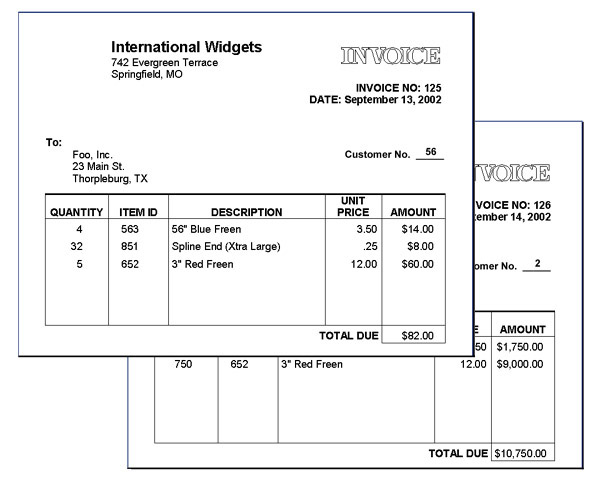
Those of us who have an ordered mind but aren't quite aware of relational databases might decide to use a spreadsheet, such as Microsoft Excel.
Figure A-1: orders spreadsheet

This isn't a bad approach, since it records every purchase made by every customer. But what if you start to ask complicated questions, such as:
Take a look at rows 2, 3 and 4 on the spreadsheet in Figure A-1. These represent all the data we have for a single invoice (Invoice #125).
In database lingo, this group of rows is referred to as a single database row. Never mind the fact that one database row is made up here of three spreadsheet rows: It's an unfortunate ambiguity of language. Academic database theoreticians have a special word that helps a bit with the ambiguity: they refer to the "thing" encapsulated by rows 2, 3 and 4 as a tuple (pronounced tu'ple or too'ple). We're not going to use that word here (and if you're lucky, you'll never hear it again for the rest of your life). Here, we will refer to this thing as a row.
So, First Normal Form (NF1) wants us to get rid of repeating elements. What are those?
Again we turn our attention to the first invoice (#125) in Figure A-1. Cells H2, H3, and H4 contain a list of Item ID numbers. This is a column within our first database row. Similarly, I2-I4 constitute a single column; same with J2-J4, K2-K4, L2-L4, and M2-M4. Database columns are sometimes referred to as attributes (rows/columns are the same as tuples/attributes).
You will notice that each of these columns contains a list of values. It is precisely these lists that NF1 objects to: NF1 abhors lists or arrays within a single database column. NF1 craves atomicity: the indivisibility of an attribute into similar parts.
Therefore it is clear that we have to do something about the repeating item information data within the row for Invoice #125. On Figure A-1, that is the following cells:
Similar (though not necessarily identical) data repeats within Invoice #125's row.
We can satisfy NF1's need for atomicity quite simply: by separating each item in these lists
into its own row, as in Figure A-2.

Figure A-2: flattened orders spreadsheet

I can hear everyone objecting: We were trying to reduce the amount of duplication, and here we have introduced more! Just look at all that duplicated customer data!
Don't worry. The kind of duplication that we introduce at this stage will be addressed when we get to the Third Normal Form.
We have actually only told half the story of NF1. Strictly speaking, NF1 addresses two issues:
We have already dealt with atomicity. But to make the point about Primary Keys, we shall bid farewell to the spreadsheet and move our data into a relational database management system (RDBMS). Here we shall use Microsoft Access to create the orders table, as in Figure B:

This looks pretty much the same as the spreadsheet, but the difference is that within an RDBMS we can identify a primary key. A primary key is a column (or group of columns) that uniquely identifies each row.
As you can see from Figure B, there is no single column that uniquely identifies each row. However, if we put a number of columns together, we can satisfy this requirement.
The two columns that together uniquely identify each row are order_id and item_id: no two rows have the same combination of order_id and item_id. Therefore, together they qualify to be used as the table's primary key. Even though they are in two different table columns, they are treated as a single thing. We call them concatenated.
A value that uniquely identifies a row is called a primary key.
When this value is made up of two or more columns, it is referred to as a concatenated primary key.
The underlying structure of the orders table can be represented as
Figure C.

We identify the columns that make up the primary key with the PK notation. Figure C is the beginning of our Entity Relationship Diagram (or ERD).
Our database schema now satisfies the two requirements of First Normal Form: atomicity and uniqueness. Thus it fulfills the most basic criterion of a relational database.
What's next?
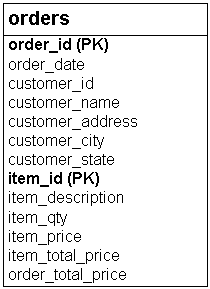
Next we test each table for partial dependencies on a concatenated key. This means that for a table that has a concatenated primary key, each column in the table that is not part of the primary key must depend upon the entire concatenated key for its existence. If any column only depends upon one part of the concatenated key, then we say that the entire table has failed Second Normal Form and we must create another table to rectify the failure.
Still not clear? To try and understand this, let's take apart the orders table column by column. For each column we will ask the question,
Can this column exist without one or the other part of the concatenated primary key?
If the answer is "yes" — even once — then the table fails Second Normal Form.
Refer to Figure C again to remind us of the orders table structure.

First, recall the meaning of the two columns in the primary key:
We don't analyze these columns (since they are part of the primary key). Now consider the remaining columns...
order_date is the date on which the order was made. Obviously it relies on order_id; an order date has to have an order, otherwise it is only a date. But can an order date exist without an item_id?
The short answer is yes: order_date relies on order_id, not item_id. Some of you might object, thinking that this means you could have a dated order with no items (an empty invoice, in effect). But this is not what we are saying at all: All we are trying to establish here is whether a particular order on a particular date relies on a particular item. Clearly, it does not. The problem of how to prevent empty orders falls under a discussion of "business rules" and could be resolved using check constraints or application logic; it is not an issue for Normalization to solve.
Therefore: order_date fails Second Normal Form.
![]()
But let's continue with testing the other columns. We have to find all the columns that fail the test, and then we do something special with them.
customer_id is the ID number of the customer who placed the order. Does it rely on order_id? No: a customer can exist without placing any orders. Does it rely on item_id? No: for the same reason. This is interesting: customer_id (along with the rest of the customer_* columns) does not rely on either member of the primary key. What do we do with these columns?
We don't have to worry about them until we get to Third Normal Form. We mark them as "unknown" for now.
![]()
item_description is the next column that is not itself part of the primary key. This is the plain-language description of the inventory item. Obviously it relies on item_id. But can it exist without an order_id?
Yes! An inventory item (together with its "description") could sit on a warehouse shelf forever,
and never be purchased... It can exist independent of an order. item_description fails the test.
![]()
item_qty refers to the number of items purchased on a particular invoice. Can this
quantity exist without an item_id? Impossible: we cannot talk about the "amount of nothing" (at
least not in database design). Can the quantity exist without an order_id? No: a quantity
that is purchased with an invoice is meaningless without an invoice. So this column does not
violate Second Normal Form: item_qty depends on both parts of
our concatenated primary key.
![]()
item_price is a tricky one. At first glance it seems similar to item_description: the price of an item has nothing to do with the order it is part of, it depends only on the item_id and thus violates Second Normal Form. But let's think a little bit about that. What happens if the price of an item changes? What if you need to keep track of the changing item price over time?
A common-sense thing to do would be to regard the item price as dependent on both the item and the order.
Whether this solution is appropriate or not would depend on the needs of the business you are modelling.
The point is that this is not a question that can be addressed by the Normalization process alone;
once again, we have a matter that falls under the discussion of business rules. For the sake of simplicity
I have chosen to create this tutorial in a world where prices never change, and within this static and
rarified world, item_price fails Second Normal Form.
![]()
item_total_price is another tricky one, but for a different reason. On the one hand, it seems to depend on both order_id and item_id, in which case it passes Second Normal Form. On the other hand, it is a derived value: it is merely the product of item_qty and item_price. What to do with this field?
In fact, this field does not belong in our database at all. It can easily be reconstructed outside of the database proper; to include it would be redundant (and could quite possibly introduce corruption). Therefore we will discard it and speak of it no more.

order_total_price, the sum of all the item_total_price fields for a particular order, is another derived value. We discard this field too.
Here is the markup from our NF2 analysis of the orders table:

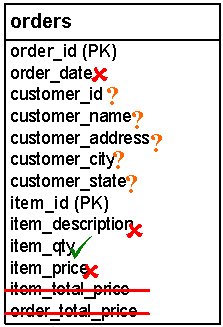
What do we do with a table that fails Second Normal Form, as this one has? First we take out the second half of the concatenated primary key (item_id) and put it in its own table.
All the columns that depend on item_id - whether in whole or in part - follow it into the new table. We call this new table order_items (see Figure D).
The other fields - those that rely on just the first half of the primary key (order_id) and those we aren't sure about - stay where they are.
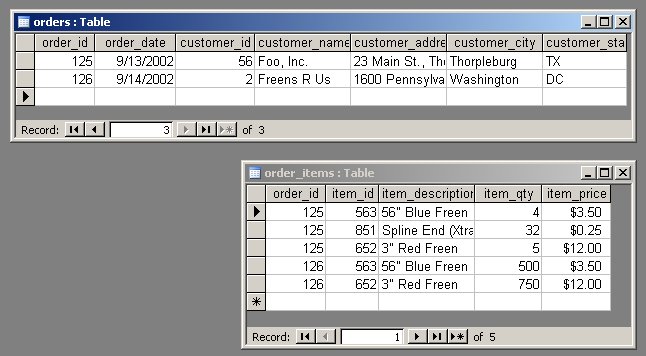
There are several things to notice:
Here is the table structure (Figure E):

If you are new to Entity Relationship Diagrams, pay close attention to the line that connects these two tables. This line means, in English,
There are other ways of depicting these table-to-table relationships; here I am using one of many standard conventions.

But wait, there's more!
Remember, NF2 only applies to tables with a concatenated primary key. Now that orders has a single-column primary key, it has passed Second Normal Form. Congratulations!
order_items, however, still has a concatenated primary key. We have to pass it through the NF2 analysis again, and see if it measures up. We ask the same question we did before:
Can this column exist without one or the other part of the concatenated primary key?
First, refer to Figure F, to remind us of the order_items table structure.

Now consider the columns that are not part of the primary key...
item_description relies on item_id, but not order_id.
So (surprise), this column once again fails NF2.
![]()
item_qty relies on both members of the primary key. It does not violate NF2.
![]()
item_price relies on the item_id
but not on the order_id, so it does violate Second Normal Form.
![]()
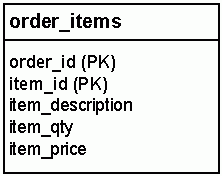
We should be getting good at this now...

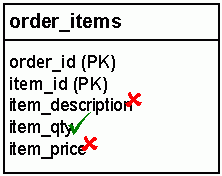

But wait, something's wrong. When we did our first pass through the NF2 test, we took out all the fields that relied on item_id and put them into the new table. This time, we are only taking the fields that failed the test: in other words, item_qty stays where it is. Why? What's different this time?
The difference is that in the first pass, we removed the item_id key from the orders table altogether, because of the one-to-many relationship between orders and order-items. Therefore the item_qty field had to follow item_id into the new table.
In the second pass, item_id was not removed from the order_items table because of the many-to-one relationship between order-items and items. Therefore, since item_qty does not violate NF2 this time, it is permitted to stay in the table with the two primary key parts that it relies on.

This should be clearer with a new ERD. Here is how the items table fits into the overall database schema:

The line that connects the items and order_items tables means the following:

These two lines are examples of one-to-many relationships. This three-table structure, considered in its entirety, is how we express a many-to-many relationship:
Each order can have many items; each item can belong to many orders.
Notice that this time, we did not bring a copy of the order_id column into the new table. This is because individual items do not need to have knowledge of the orders they are part of. The order_items table takes care of remembering this relationship via the order_id and item_id columns. Taken together these columns comprise the primary key of order_items, but taken separately they are foreign keys or pointers to rows in other tables. More about foreign keys when we get to Third Normal Form.
Notice, too, that our new table does not have a concatenated primary key, so it automatically passes NF2. At this point, we have succeeded in attaining Second Normal Form!
At last, we return to the problem of the repeating Customer information. As our database now stands, if a customer places more than one order then we have to input all of that customer's contact information again. This is because there are columns in the orders table that rely on "non-key attributes".
To better understand this concept, consider the order_date column. Can it exist independent of the order_id column? No: an "order date" is meaningless without an order. order_date is said to depend on a key attribute (order_id is the "key attribute" because it is the primary key of the table).
What about customer_name — can it exist on its own, outside of the orders table?
Yes. It is meaningful to talk about a customer name without referring to an order or invoice. The same goes for customer_address, customer_city, and customer_state. These four columns actually rely on customer_id, which is not a key in this table (it is a non-key attribute).
These fields belong in their own table, with customer_id
as the primary key (see Figure I).

However, you will notice in Figure I that we have severed the relationship between the orders table and the Customer data that used to inhabit it.
This won't do at all.
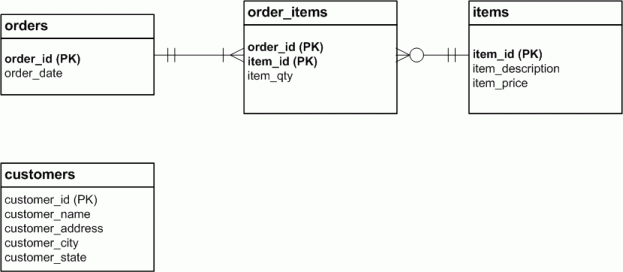
We have to restore the relationship by creating something called a foreign key
(indicated in our diagram by (FK)) in the orders table.
A foreign key is essentially a column that points to the primary key in another table.
Figure J describes this relationship:

The relationship that has been established between the orders and customers table may be expressed in this way:
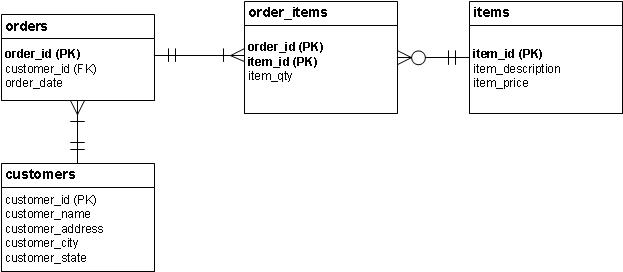
One final refinement...
You will notice that the order_id and item_id columns in order_items perform a dual purpose: not only do they function as the (concatenated) primary key for order_items, they also individually serve as foreign keys to the order table and items table respectively.
Figure J.1 documents this fact, and shows our completed ERD:

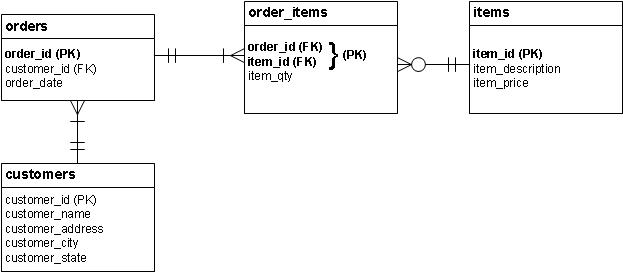
And finally, here is what the data in each of the four tables looks like. Notice that NF3 removed columns from a table, rather than rows.
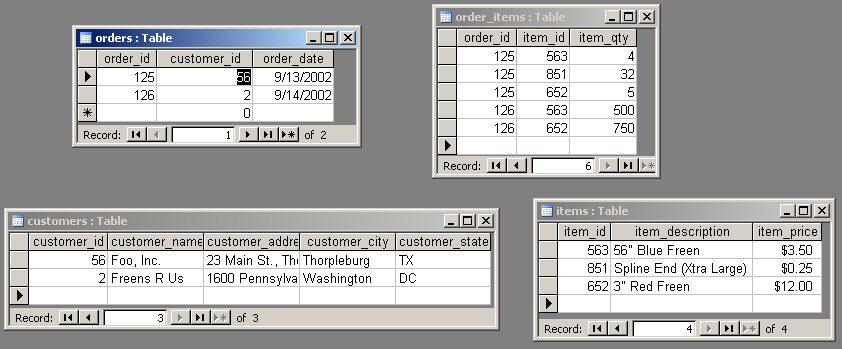
 |
Comment on this | |
 |
Download a printable PDF | |
If you believe you found a
mistake or want to rake me over the coals for some reason,
please write me a private note.
References for Further Reading
Needless to say, normalization is a vast topic and we have only scratched the surface. If you want to read more
about the theory and practice of the 3 Normal Forms, here are some suggestions: